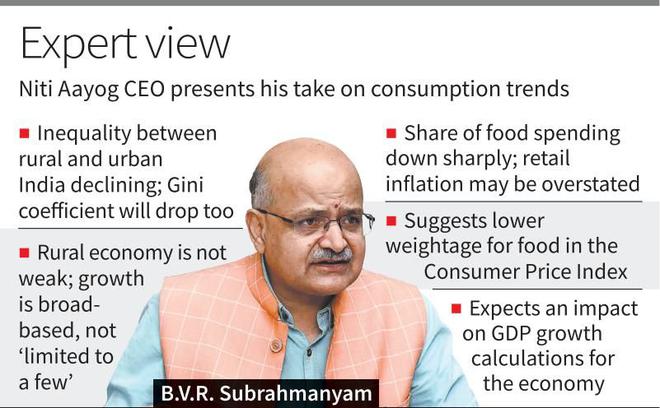Less than 5% of Indians are now expected to be below the poverty line, and extreme destitution has almost gone away, a top government official asserted on February 25, citing the findings of the Household Consumption Expenditure Survey (HCES) for 2022-23. Retail inflation has also likely been overstated in recent years, he added.
Dismissing the narrative that the rural economy is weak and India’s growth story is ‘restricted to a few people’, B.V.R. Subrahmanyam, the chief executive officer of the Centre’s think tank Niti Aayog, averred that growth is “broad-based” with rural Indians’ incomes and spends rising faster than their urban peers.
The urban-rural consumption divide has narrowed to 71% in 2022-23 from a peak of 91% in 2004-05, so inequality is declining, he said, even as rural households’ spending on food has dropped below 50% of their total expenditure for the first time ever.

Food spending changes
Lower spends on pulses and cereals — which dropped below 5% of per capita consumer expenditure as per the latest survey — and higher expenditures on conveyances, consumer durables, and consumer services indicates that people are earning more and need to spend a lesser share of their income on food, Mr. Subrahmanyam argued.
“It’s not that consumption levels of food are going down in absolute terms, but the relative spending on food is declining while consumption of products like TVs, fridges, mobile phones, and cars have increased. This not only means there is a change in incomes for the better, but also a change in lifestyles,” he pointed out.
“Within food, we see the consumption of beverages, processed food, milk, and fruits is going up, an indication of more diverse and balanced food consumption,” he added. Mr. Subrahmanyam noted that this was the first official data since 2011-12 and was much-awaited as there were inconsistencies in the 2017-18 Survey data, which was “just preceded by demonetisation”.
Poverty math
Citing the Monthly Per Capita Expenditure (MPCE) averages across fractile classes in 2022-23, Mr. Subrahmanyam noted that ₹1,373 was the average consumption level for the bottom 5% of rural households, while it was ₹1,782 for the next 5% of households.
“Poverty lines and estimates are derived from this. We have had four, five different informal estimates for poverty in the absence of the 2017-18 Survey findings. If we go by ₹32 a day, which was the last accepted poverty line as of 2011-12, and factor in inflation trends since then to double that level to about ₹60 a day, then you will see that poverty is less than 10%, as ₹1,782 is the average spending by those in the bottom 5% to 10% fractile class in rural India,” he said.
“I am convinced poverty in India is certainly in the low single digits, and below 5% is what this data shows, if you add the imputed value of food transfers and subsidies received by households under schemes like the PM Garib Kalyan Anna Yojana or subsidised gas cylinders,” Mr. Subrahmanyam underlined.
‘Destitution almost gone’
Moreover, benefits like healthcare under the Ayushman Bharat scheme, and free education have not been factored into the consumption expenditure survey. “In a way, destitution and deprivation have almost gone,” he said. As per the Niti Aayog’s multi-dimensional poverty index, 11% of the population was below the poverty line last year, based on which it has argued that 25 crore people have escaped poverty.
“The big picture is, there is a sharp rise in urban and rural consumption by over 2.5 times from 2011-12 levels in current prices, and the big story is that India’s growth is not restricted to a few, but is very broad-based,” Mr. Subrahmanyam said.
“The rise of consumption, which is a proxy for income levels, is faster in rural India than urban India, which challenges the stories that the rural economy is weak and stagnating while rich urban Indians are buying SUVs,” he stressed.







